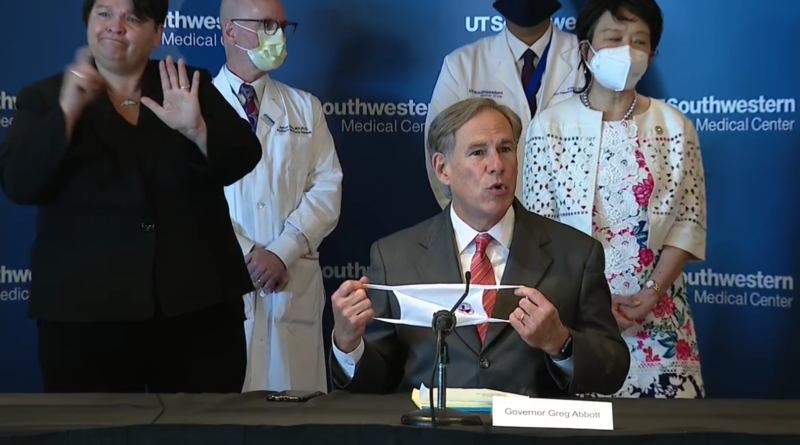Abbott Extends State Disaster Declaration
As cases continue to drop, but not flatten, state and local officials are keeping an eye on the next major test for the state: the return to on-campus instruction at schools. Among the confusion is some encouraging news – families can once again visit their loved ones in long-term care facilities, albeit with some caveats.
Here are today’s bullet points:
- Gov. Greg Abbott extends the state disaster declaration;
- Daily cases remain between 400 and 850 throughout weekend;
- State health officials allow limited visitation to long-term care facilities;
- Dallas County offers assistance to food pantries.
Abbott Extends State Disaster Declaration
Over the weekend, Gov. Greg Abbott extended the state disaster declaration issued on March 13 in response to the COVID-19 pandemic.
The declaration allows the state to utilize more resources as it continues to try to slow the spread of the virus.
“Renewing this Disaster Declaration will provide communities with the resources they need to respond to COVID-19,” said Abbott. “I urge Texans to remain vigilant in our fight against this virus. Everyone must do their part to slow the spread of COVID-19 by wearing a mask, practicing social distancing, and washing your hands frequently and thoroughly. We will overcome this challenge by working together.”
The extension comes as many schools in the area begin to reopen for the new school year, albeit some online only.
Daily Cases Remain Between 400 and 850 Throughout Weekend
A total of 1,805 new cases of the novel coronavirus were reported by Dallas County health officials between Friday and Sunday, and an additional 19 deaths, bringing the county’s total case count up to 54,674, including 755 confirmed deaths
For reference, last Sunday, the total case count was 51,108, and 688 deaths.
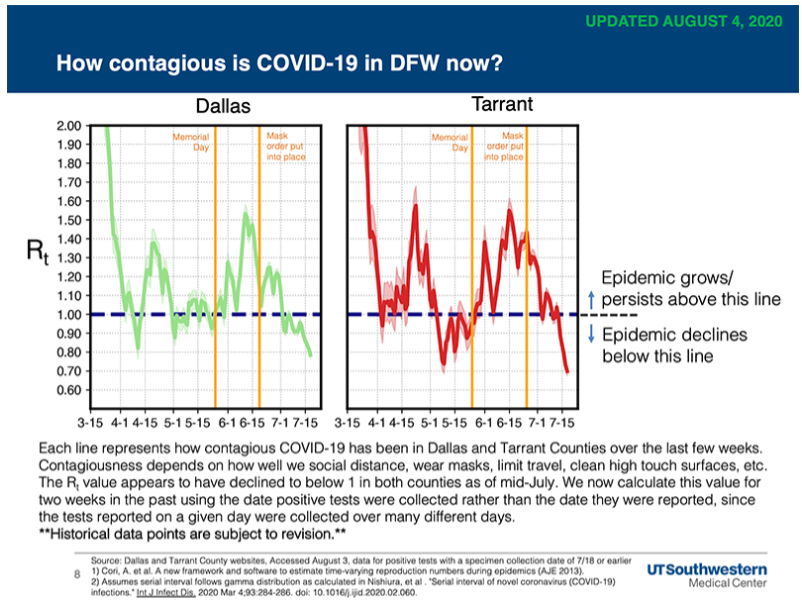
On Friday, the county reported 422 confirmed cases, 10 confirmed deaths, and an additional 167 probable cases and five probable deaths; on Saturday, 540 confirmed cases, five confirmed deaths, 43 additional probable cases, and six additional probable deaths; and on Sunday 843 confirmed cases, four confirmed deaths, 130 additional probable cases, and six probable deaths.
Among the dead are a Garland man in his 50s, a Dallas man in his 50s, a Balch Springs man in his 50s with no underlying high-risk health conditions, an Irving man in his 60s, a Dallas woman in her 60s with no underlying high-risk health conditions, two Dallas men in their 60s, a Balch Springs man in his 60s, a Richardson man in his 60s, a Grand Prairie woman in her 70s, a Dallas man in his 70s, a Farmers Branch woman in her 70s, a Dallas woman in her 70s, and a Garland woman in her 80s. All, unless noted, had underlying high-risk health conditions.
Long-term care facilities continue to account for a third of all COVID-19 deaths, including two women in their 70s who lived in Dallas facilities, a man in his 80s who lived in a Dallas facility, a woman in her 80s who lived in a Dallas facility, and a woman in her 80s who lived in a Lancaster facility.
The county said that the number of COVID-19 hospitalizations Friday was 588 patients. Emergency room visits for COVID-19 symptoms also remain high, representing about 24% of all ER visits, according to information reported to the North Central Texas Trauma Regional Advisory Council.
“If we continue to stay on the course that we’re on with masking and good decision making, I believe we can continue to see a decline that will get less people sick, keep more businesses open and get our kids back to school and activities sooner rather than later,” said Dallas County Judge Clay Jenkins on Friday.
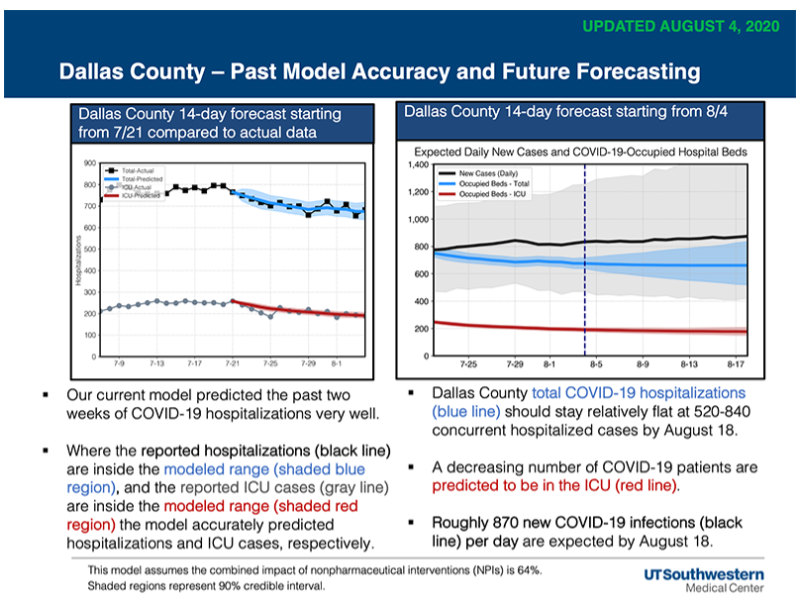
UT Southwestern’s latest forecast projects that by August 18, Dallas County hospitals could see concurrent hospitalizations stay relatively flat at between 520 and 840 cases. As previously reported, there is a gap in hospitalization data due to a change in the reporting system, but the researchers expect that if hospitalizations (which are a lagging indicator) follow the most recent case counts, the area could see a reduction in hospitalizations over the next few weeks.
In the county’s August 7 aggregate report, most confirmed cases continue to be between the ages of 18 and 60, with the 18-40 age group accounting for 46% of the cases, and the 41-64 age group accounting for another 35% of the total cases.
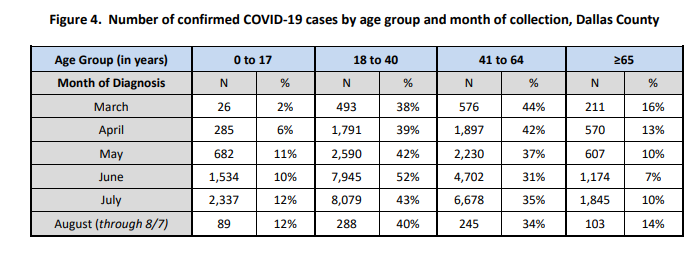
Over 2,514 children under 18 years of age have been diagnosed with COVID-19 since July 1. During this timeframe, 61 children have been hospitalized for COVID-19. Of all confirmed cases requiring hospitalization to date, more than two-thirds have been under 65 years of age.
Close contact or community transmission continues to be the biggest risk factor for contracting COVID-19, accounting for more than 92% of all cases. Being incarcerated in a federal prison, living in a long-term care facility or being incarcerated in the county jail are a distant second, third, and fourth, at 2.5%, 2.3% and 1.2%, respectively.
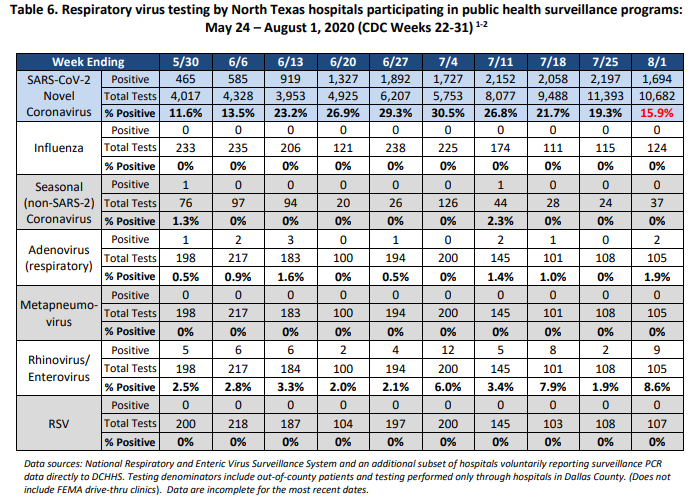
Of the testing done, positive cases accounted for 15.9% as of Aug. 1, with 1,694 positives coming from 10,682 tests. Testing for the week prior found that positive cases accounted for 19.3% of all testing.
Thirteen percent of all cases ended up hospitalized – 21% ended up in intensive care, and 12% ended up on a ventilator.
In a city-by-city breakdown, Dallas still comes in with the highest number of cases – 28,534, or 53.5%. Highland Park has 41 cases so far, and University Park has 85 (up from 78).
State Health Officials Allow Limited Visitation to Long-Term Care Facilities
The Texas Health and Human Services Commission Thursday announced that some nursing homes and long-term care facilities would be able to welcome visitors – but on an extremely limited basis.
The agency also issued enhanced emergency rules for facilities designed to help mitigate the spread of the virus.
“This is a rapidly evolving situation and we are constantly assessing what actions are necessary to keep residents and staff safe in these facilities,” said HHSC executive director Phil Wilson. “By following these procedures and rules, facilities can more effectively prevent the spread of COVID-19 and help us achieve our shared goal of reuniting residents with their families and friends.”
For nursing facilities, visitation is limited to outdoor visits only, and physical contact between residents and visitors is not allowed. Facilities must meet certain conditions before they can allow visitation, including having no positive COVID-19 cases among the staff in the last 14 days, no active positive cases among residents, weekly testing for all staff, and any facility that had a previous outbreak must be fully recovered and adequately staffed, as well as following adequate infection control procedures.
“Access to family and loved ones is an important part of every resident’s health and well-being, which is why this policy shift is a move in the right direction for some of our most fragile Texans,” said State Sen. Lois Kolkhorst (SD-18), Senate Committee on Health and Human Services chair.
Long-term care facilities that are not nursing facilities can have limited indoor and outdoor visitation, but physical contact is still not permitted, and facilities must use a plexiglass barrier for indoor visitation. Staff must not have any confirmed positive cases in the last 14 days, and there cannot be any active cases in residents. The facility must also make sure it has enough staff to enforce protection control procedures.
“Today’s announcement is a critical first step for every person in a long-term care facility and their loved ones,” said State Rep. James Frank (HD-69), Texas House Committee on Human Services chair. “This decision underscores that state leaders recognize the need to balance the emotional and physical health impacts of isolation against the serious dangers that COVID poses to these vulnerable Texans.”
In addition, the agency enacted enhanced emergency rules for nursing facilities that include:
- Each facility must have a COVID-19 response plan that includes designated staff to work with cohorts of residents who have tested positive for COVID-19, and staff should not change designation from one day to another, unless required to maintain adequate staffing for a cohort.
- All nursing facilities must screen all residents, staff, and people who come to the facility in accordance with specified criteria, and each resident must be screened at least three times a day for signs or symptoms of COVID-19.
- Each facility must have plans for obtaining and maintaining a two-week supply of personal protective equipment and resident recovery plans for continuing care when a resident recovers from COVID-19.
Dallas County Offers Assistance to Food Pantries
Dallas County will begin taking applications for its Food Pantry Assistance Program beginning today, county commissioner Elba Garcia said.
To be eligible, a pantry must meet the following requirements:
- Be in operation on or before March 1, 2019;
- Be current in the payment of all Dallas County and local taxes;
- Must be physically located in Dallas County (excluding the City of Dallas) with a physical Dallas County mailing address;
- Demonstrate increased food assistance or cost since March 1, 2020 due to responding to the COVID-19 public health emergency.
To apply for this program, visit http://www.dallascounty.org/cares-act/food-pantry-en.php

